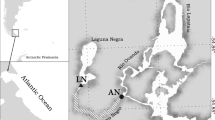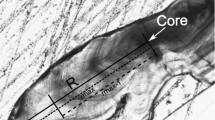Abstract
Protogynous sequential hermaphroditism is very common in marine fish. Despite a large number of studies on various aspects of sequential hermaphroditism in fish, the relationship between body shape and colour during growth in dichromatic species has not been assessed. Using geometric morphometrics, the present study explores the relationship between growth, body shape and colouration in Coris julis (L. 1758), a small protogynous labrid species with distinct colour phases. Results show that body shape change during growth is independent of change in colour phase, a result which can be explained by the biology of the species and by the social control of sex change. Also, during growth the body grows deeper and the head has a steeper profile. It is hypothesized that a deeper body and a steeper profile might have a function in agonistic interactions between terminal phase males and that the marked chromatic difference between colour phases allows the lack of strict interdependence of body shape and colour during growth.




Similar content being viewed by others
References
Arigoni S, Francour P, Harmelin-Vivien M, Zaninetti L (2002) Adaptive colouration of Mediterranean labrid fishes to the new habitat provided by the introduced tropical alga Caulerpa taxifolia. J Fish Biol 60:1486–1497
Barber CB, Dobkin DP, Huhdanpaa HT (1996) The Quickhull algorithm for convex hulls. ACM T Math Software 22(4):469–483
Barlow GW (1998) Sexual-selection models for exaggerated traits are useful but constraining. Am Zool 38:59–69
Barlow GW, Siri P (1997) Does sexual selection account for the conspicuous head dimorphism in the Midas cichlid? Anim Behav 52:573–584
Bentivegna F, Cirino P (1984) Sexual inversion in Coris julis L. 1758. Cybium 8(2):51–61
Bentivegna F, Cirino P, Rasotto MB (1985) Further investigations into sex reversal of Coris julis L. (Pisces, Labridae). Boll Zool 52:355–358
Bookstein FL (1989) Size and shape: a comment on semantics. Syst Zool 38:173–180
Bookstein FL (1997) Landmark methods for forms without landmarks: localizing group differences in outline shape. Med Image Anal 1:225–243
Bruslé S (1987) Sex-inversion of the hermaphroditic, protogynous teleost Coris julis L. (Labridae). J Fish Biol 30:605–616
Cornwell WK, Schwilk DW, Ackerly DD (2006) A trait-based test for habitat filtering: convex hull volume. Ecology 87(6):1465–1471
Frisch A (2004) Sex-change and gonadal steroids in sequentially-hermaphroditic teleost fish. Rev Fish Biol Fisher 14:481–499
Fruciano C (2009) Pattern di variazione morfologica e molecolare in Coris julis (L. 1758) (Teleostei, Labridae). Doctoral thesis, University of Catania.
Fruciano C, Hanel R, Debes PV, Tigano C, Ferrito V (2011a) Atlantic-Mediterranean and within-Mediterranean molecular variation in Coris julis (L. 1758) (Teleostei, Labridae). Mar Biol 158:1271–1286
Fruciano C, Tigano C, Ferrito V (2011b) Geographic morphological variation within and between colour phases in Coris julis (L. 1758), a protogynous marine fish. Biol J Linn Soc 104:148–162
Fruciano C, Ferrito V, Tigano C (2011c) Traditional and geometric morphometrics detect morphological variation of lower pharyngeal jaw in Coris julis (Teleostei, Labridae). Ital J Zool 78(3):320–327
Gomon MF, Randall JE (1984) Labridae. In: Fischer W and Bianchi G (eds) FAO species identification sheets for fishery purposes. Western Indian Ocean fishing area 51. Vol. 2.
Inselberg A (1985) The plane with parallel coordinates. Visual Comput 1:69–91
Klingenberg CP (2011) MorphoJ: an integrated software package for geometric morphometrics. Mol Ecol Res 11:353–357
Kuwamura T, Karino K, Nakashima Y (2000) Male morphological characteristics and mating success in a protogynous coral reef fish, Halichoeres melanurus. J Ethol 18:17–23
Lejeune P (1982) A propos de quelques Poissons de la Mediterraneé. Revue Francaise d’Aquariologie 9(1):27–32
Michel C, Lejeune P, Voss J (1987) Biologie et comportement des Labridés européens (Labres, Crénilabres, Rouquiers, Vieilles et Girelles). Revue française d’Aquariologie 14:1–180
Mitteroecker P, Gunz P, Bernhard M, Schaefer K, Bookstein FL (2004) Comparison of cranial ontogenetic trajectories among great apes and humans. J Hum Evol 46:679–698
Mullin SK, Taylor PJ (2002) The effects of parallax on geometric morphometric data. Comput Biol Med 32:455–464
Muñoz RC, Warner RR (2003) A new version of the size-advantage hypothesis for sex change: incorporating sperm competition and size-fecundity skew. Am Nat 161(5):749–761
Muñoz RC, Warner RR (2004) Testing a new version of the size-advantage hypothesis for sex change: sperm competition and size-skew effects in the bucktooth parrotfish, Sparisoma radians. Behav Ecol 15(1):129–136
Ohta K, Hirano M, Mine T, Mizutani H, Yamaguchi A, Matsuyama M (2008) Body color change and serum steroid hormone levels throughout the process of sex change in the adult wrasse, Pseudolabrus sieboldi. Mar Biol 153(5):843–852
Perez IS, Bernal V, Gonzalez PN (2006) Differences between sliding semilandmark methods in geometric morphometrics, with an application to human craniofacial and dental variation. J Anat 208:769–784
Randall JE, Kuiter RH (1982) Three new Labrid fishes of the genus Coris from the Western Pacific. Pac Sci 36(2):159–173
Reinboth R (1967) Biandric Teleost species. Gen Comp Endocr, Abstracts, 9: no. 146.
Reinboth R (1975) Spontaneous and hormone-induced sex-inversion in wrasses (Labridae). Pubblicazioni della Stazione Zoologica di Napoli 39(suppl):550–573
Reinboth R (1988) Physiological problems of teleost ambisexuality. Environ Biol Fish 22(4):249–259
Reinboth R, Brusle-Sicard S (1997) Histological and ultrastructural studies on the effects of hCG on sex inversion in the protogynous teleost Coris julis. J Fish Biol 51:738–749
Rohlf FJ (2006) tpsDig, digitize landmarks and outlines, version 2.10. Department of Ecology and Evolution, State University of New York at Stony Brook.
Rohlf FJ (2007a) tpsRelw, relative warps analysis, version 1.45. Department of Ecology and Evolution, State University of New York at Stony Brook.
Rohlf FJ (2007b)tpsRegr, shape regression, version 1.33. Department of Ecology and Evolution, State University of New York at Stony Brook.
Shapiro DY (1979) Social behavior, group structure, and the control of sex reversal in hermaphroditic fish. In: Rosenblatt JS, Hinde RA, Beer C and Busnel M-C (eds), Advances in the Study of Behavior, Academic PressVolume 10, Pages 43–102, ISSN 0065–3454, ISBN 9780120045105, doi: 10.1016/S0065-3454(08)60093-5.
Shapley RL (2004) Assessing parallel coordinates visualizations for prestatistical exploration of biological systematics data. Unpublished report
Tortonese E (1970) Fauna d'Italia - Osteichthyes - Pesci Ossei. Ed. Calderini Bologna.
Valentin AE, Penin X, Chanut J-P, Sévigny J-M, Rohlf FJ (2008) Arching effect on fish body shape in geometric morphometric studies. J Fish Biol 73:623–638
Warner RR (1984) Mating behavior and hermaphroditism in coral reef fishes. Am Sci 72(2):128–136
Warner RR (1988) Sex change in fishes: hypotheses, evidence, and objections. Env Biol Fish 22(2):81–90
Warner RR, Muñoz RC (2008) Needed: a dynamic approach to understand sex change. Anim Behav 75:e11–e14
Warner RR, Robertson DR (1978) Sexual patterns in the labroid fishes of the western Caribbean, I: the Wrasses (Labridae). Smithson Contrib Zool 254:1–27
Warner RR, Schultz ET (1992) Sexual selection and male characteristics in the bluehead wrasse, Thalassoma bifasciatum: mating site acquisition, mating site defense, and female choice. Evolution 46(5):1421–1442
Wegman EJ (1990) Hyperdimensional data analysis using parallel coordinates. J Am Stat Assoc 85:664–675
Acknowledgements
The authors would like to acknowledge the precious contribution of F. James Rohlf who provided many useful suggestions at multiple stages. Enrico Arneri, Ferdinando Boero, G. Andrea de Lucia, Paolo Domenici, Maria Ghelia, Paolo Guidetti, Miquel Palmer, Sergio Ragonese, Alfonso Toscano and Nedo Vrgoc kindly helped in obtaining specimens used in the analysis.
Author information
Authors and Affiliations
Corresponding author
Electronic supplementary material
Below is the link to the electronic supplementary material.
Supplementary Fig. S1
Parallel coordinate plot of the first ten relative warps for all the studied specimens. Yellow = primary, blue = transition, pink = secondary. The plot shows a considerable overlap of the morphospace portions occupied by each colour phase (PDF 24 kb)
Supplementary Fig. S2
Parallel coordinate plot of the first ten relative warps. For each colour phase only the quartiles are shown to highlight the degree of overlap among groups. Yellow = primary, blue = transition, pink = secondary. The plot shows that the overlap in morphospace occupation of primary, transitional and secondary individuals is not caused by a few outliers but it is evident even considering only the quartiles of the relative warps of each colour phase (PDF 15 kb)
Rights and permissions
About this article
Cite this article
Fruciano, C., Tigano, C. & Ferrito, V. Body shape variation and colour change during growth in a protogynous fish. Environ Biol Fish 94, 615–622 (2012). https://doi.org/10.1007/s10641-011-9968-y
Received:
Accepted:
Published:
Issue Date:
DOI: https://doi.org/10.1007/s10641-011-9968-y




